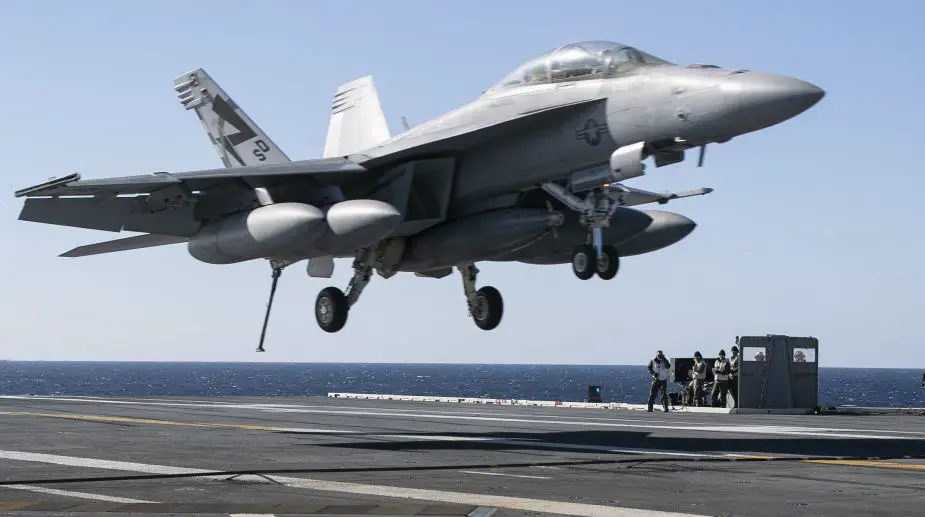Breaking news
USS Gerald R Ford CVN-78 completed Aircraft Compatibility Testing.
The aircraft carrier USS Gerald R. Ford (CVN 78) completed Aircraft Compatibility Testing (ACT) Jan. 31, following 16 days at sea, during which the crew launched and recovered 211 aircraft, testing five different airframes, using first generation, state-of-the-art flight deck systems.
 An F/A-18F Super Hornet, assigned to Air Test and Evaluation Squadron (VX) 23, lands aboard the aircraft carrier USS Gerald R. Ford (CVN 78).(source: US Navy )
An F/A-18F Super Hornet, assigned to Air Test and Evaluation Squadron (VX) 23, lands aboard the aircraft carrier USS Gerald R. Ford (CVN 78).(source: US Navy )
ACT (Aircraft Compatibility Testing) continues the at-sea testing of Electromagnetic Aircraft Launch System (EMALS) and Advanced Arresting Gear (AAG) - two Aircraft Launch and Recovery Equipment (ALRE) systems unique to Ford – previously conducted in 2018 by the F/A-18 E/F Super Hornet. The testing phase included the first-ever underway catapult launches and arrested landings for the T-45 Goshawk and E/A-18G Growler from Air Test and Evaluation Squadron 23 (VX-23); as well as the E-2D Advanced Hawkeye and C-2A Greyhound, from Air Test and Evaluation Squadron 20 (VX-20). Crews also tested F/A-18F Super Hornets from VX-23, which earlier had conducted initial compatibility tests on board Ford in 2017.
ACT began on Jan. 16 and concluded with 211 successful launches and arrestments using EMALS and AAG technology. The Gerald R. Ford now has 958 total traps to date and will likely surpass 1,000 launches and arrestments during the upcoming Flight Deck Certification (FDC) phase, currently scheduled for March, when her crew and Carrier Air Wing (CVW) Eight will take over all aspects of flight operations. The crew is fully prepared for FDC, having already received hands-on experience with EMALS and AAG via several training and test events.
ACT also allowed the crew and embarked test personnel to qualitatively evaluate the effect of the Ford-class air wake, or burble, and its compatibility with all types of fleet aircraft the Navy uses on an aircraft carrier. Aircraft were launched and recovered in different environmental conditions and sea states, and with varying aircraft weights—from heavy aircraft in light wind conditions to light aircraft in heavy wind conditions.
EMALS is the launch system of choice for Ford and all future Ford-class aircraft carriers. Its mission and function remain the same as traditional steam catapults; however, it employs entirely different technologies. EMALS uses stored kinetic energy and solid-state electrical power conversion. This technology permits a high degree of computer control, monitoring and automation. The system will also provide the capability for launching all current and future carrier air wing platforms – lightweight unmanned to heavy strike fighters.
The software-controlled AAG is a modular, integrated system that consists of energy absorbers, power conditioning equipment and digital controls, with architecture that provides built-in tests and diagnostics, resulting in lower maintenance and manpower requirements. AAG is designed to provide higher reliability, increased safety margins and reduce fatigue impact load on aircraft. Similar to EMALS, it will also allow for the arrestment of all current and future air wing assets.
This second and final round of testing validated the ship’s capability to launch and to recover aircraft with ordnance loadout and fuel states mirroring deployed requirements and operating tempos, using the Electromagnetic Aircraft Launch System (EMALS) and Advanced Arresting Gear (AAG)—two Aircraft Launch and Recovery Equipment (ALRE) systems unique to Ford.
By completing T-45 testing, the Ford will be able to provide carrier qualification support to the Training Command and to student naval aviators in the jet/E-2/C-2 pipeline.




























